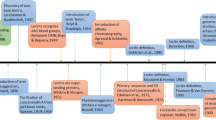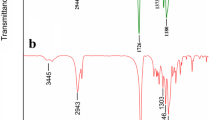Abstract
A conjugate composed of tetraaza[6.1.6.1]paracyclophane bearing carboxylic acids and lectin, a carbohydrate binding protein, was prepared. The specific saccharide-binding abilities as well as the secondary structural features of the lectin were not disturbed, when the cyclophane were covalently bound to the lectin. The conjugate was found to act as a water-soluble host for inclusion of anionic guest molecules such as 6-p-toluidino-naphthalene-2-sulfonate (TNS) and 8-anilinonaphthalene-1-sulfonate (ANS) in aqueous acetate buffer (pH 4.0) with binding constants of 4.2 × 104 and 1.5 × 104 dm3 mol−1, respectively. The obtained binding constants were much larger than those by untethered water-soluble cyclophane. A highly desolvated microenvironment was provided by the cyclophane cavity on the protein surfaces so that the tight host–guest interaction, which brought about the marked motional repression of the entrapped guests, became effective. The conjugate also showed molecular discrimination capabilities toward the anionic guests through electrostatic repulsion mechanism originating from acid-dissociation equilibrium of carboxylic acids of the cyclophane branches.
Similar content being viewed by others
References
(a) B. Hinzen, P. Seiler, and F. Diederich: Helv. Chim. Acta 79, 942 (1996); (b) F.G. Klarner and B. Kahlert: Acc. Chem. Res. 36, 919 (2003); (c) S.M. Biros, E.C. Ullrich, F. Hof, L. Trembleau, and J. Rebek: J. Am. Chem. Soc. 126, 2870 (2004)
J. Szejtli: In J. Szejtli (ed.), Comprehensive Supramolecular Chemistry, Vol. 3, Chap. 2, Pergamon, Oxford (1996), pp. 5–56
(a) K. Odashima and K. Koga: In F. Vögtle (ed.), Comprehensive Supramolecular Chemistry, Vol. 2, Pergamon, Oxford (1996), Chap. 5, pp. 143–194; (b) Y. Murakami and O. Hayashida: In F. Vögtle (ed.), Comprehensive Supramolecular Chemistry, Vol. 2, Pergamon, Oxford (1996), Chap. 13, pp. 419–438; (c) P. Timmerman, W. Verboom, and D.N. Reinhoudt: Tetrahedron 52, 2663 (1996)
(a) T.D. James, K.R.A. Sadanayake, and S. Shinkai: Nature, 375, 345 (1995); (b) J.C. Norrild and H. Eggert: J. Am. Chem. Soc. 117, 1479 (1995)
(a) J.M. Lehn: Chem. Eur. J. 5, 2455 (1999); (b) J. Rebek: Chem. Commun. 637 (2000)
(a) I. Hamachi, T. Nagase, and S. Shinkai: J. Am. Chem. Soc. 122, 12065 (2000); (b) T. Nagase, E. Nakata, S. Shinkai, and I. Hamachi: Chem. Eur. J. 9, 3660 (2003); (c) E. Nakata, T. Nagase, S. Shinkai, and I. Hamachi: J. Am. Chem. Soc. 126, 490 (2004)
(a) K. Odashima, A. Itai, Y. Iitaka, and K. Koga: J. Am. Chem. Soc. 102, 2504 (1980); (b) K. Odashima, A. Itai, Y. Iitaka, and K. Koga: J. Org. Chem. 50, 4478 (1985)
(a) Y. Nagata and M.M. Burger: J. Biol. Chem. 249, 316 (1974); (b) R.H. Rice and M.E. Etzler: Biochemistry 14, 4093 (1975)
F. Gabor U. Klausegger M. Wirth (2001) Int. J. Pharm. 221 35 Occurrence Handle10.1016/S0378-5173(01)00650-0 Occurrence Handle11397565
(a) Y. Murakami, O. Hayashida, K. Ono, and Y. Hisaeda: Pure. Appl. Chem. 65, 2319 (1993); (b) O. Hayashida, K. Ono, and Y. Murakami: Tetrahedron 51, 8423 (1995); (c) A. Casnati, F. Sansone, and R. Ungaro: Acc. Chem. Res. 36, 246 (2003)
(a) A. Marra, M.C. Schermann, A. Dondoni, A. Casnati, P. Minari, and R. Ungaro: Angew. Chem. Int. Ed. Engl. 33, 2479 (1994): (b) O. Hayashida and I. Hamachi: Chem. Lett. 32, 632 (2003); (c) O. Hayashida and I. Hamachi: J. Org. Chem. 69, 3509 (2004)
N.H. Andersen B. Cao A.R. Romero B. Arreguin (1993) Biochemistry 32 1407 Occurrence Handle10.1021/bi00057a004 Occurrence Handle8431421
(a) T. Fujimoto, C. Shimizu, O. Hayashida, and Y. Aoyama: J. Am. Chem. Soc. 119, 6676 (1997); (b) O. Hayashida, K. Nishimura, Y. Matsuda, and Y. Aoyama: Tetrahedron Lett. 40, 3407 (1999)
V.P. Bhavanandan A.W. Katlic (1979) J. Biol. Chem. 254 4000 Occurrence Handle108267
J. Slavik (1982) Biochem. Biophys. Acta 694 1 Occurrence Handle6751394
C. Reichardt, Solvents and Solvent Effects in Organic Chemistry, VCH Verlagsgesellschaft, Weinheim (1988), chapter 7
Cyclophane 2 having valine residues was used as an untethered reference host, because 2 was soluble in the acetate buffer and capable of providing a guest-binding hydrophobic cavity surrounded by valine residues
Author information
Authors and Affiliations
Corresponding author
Rights and permissions
About this article
Cite this article
Hayashida, O., Hamachi, I. Cyclophane-lectin Conjugates as a New Class of Water-soluble Host. J Incl Phenom Macrocycl Chem 53, 57–61 (2005). https://doi.org/10.1007/s10847-005-0993-3
Received:
Accepted:
Issue Date:
DOI: https://doi.org/10.1007/s10847-005-0993-3




